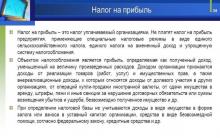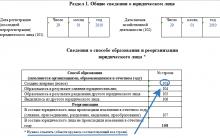We will learn what accounting is, what are its types, who are users accounting informationwhat are the tasks of accounting and what are the functions of an accountant. Let's talk about objects accounting, i.e. about what needs to be considered. We learn what constitutes the main accounting rule.
08. Filling of directories in the program 1C
We will fill out the “Nomenclature” directory, which contains data on inventory items and services. We will indicate the data of our counterparties (business partners). We will learn how to perform basic actions in list forms.
10. Entering balances in 1C. Operation log
We introduce the balance of the accounts at the beginning of the month. This will be relevant if you enter data into 1C of an enterprise that has been operating for several months or years. We will get acquainted with the journal of operations and the mechanism for reflecting accounting transactions.
11. Settlements with counterparties. Bank operations
We will buy and sell goods in bulk, transfer and receive money at cashless payments. At the same time, we will analyze different options for trading with counterparties: without prepayment, with prepayment, with partial prepayment. Also consider accounting transactionrelated to settlement and cash services of the bank.
12. Data analysis. Standard and management reports
The accountant must be able to select and sort documents in journals, as well as analyze the accumulated data using standard and management reports. Knowing the basics of analysis will help you find necessary information in a generalized and analytical form.
13. Accounting for fixed assets and intangible assets
Consider the accounting features of two types of fixed assets: fixed assets and intangible assets. Fixed assets include tangible fixed assets (buildings, structures, transport, equipment, furniture, etc.) worth more than 40,000 rubles. (in accounting). Intangible assets include permits (licenses, patents), documents confirming ownership, some software.
14. Accounting for software and low-value tangible assets
Consider the methodology for accounting for non-exclusive rights to software (and such computer programs the majority and they do not belong to intangible assets). Also consider the features of inventory accounting and household supplies. Such items do not belong to the composition of fixed assets (because their service life is not more than 12 months; or if their service life is more than 12 months, the cost is not more than 40 thousand rubles).
15. Accounting for received and sold services
Consider the features of accounting services. In the beginning, we reflect the operations for obtaining services that all accountants face. Then we analyze the operations for the provision (implementation) of services. We will also get acquainted with the peculiarity of cost accounting associated with the provision of services.
16. Accounting for cash transactions and transactions with accountable persons
Consider the features of accounting cash operations and transactions with accountable persons. In the beginning, we analyze the specifics of cash transactions (income, expense, restrictions, documentation). Then we will analyze the accounting methodology for accounting mutual settlements with accountable persons. For a specific example, consider the mechanism for reflecting cash transactions and transactions with accountable persons in the 1C program.
|
The training center at the Metropolitan Institute of Economics and Finance provides training in accounting courses for beginners. The course program includes the basic principles of organizing accounting and tax accounting, normative regulation, documentation, inventory procedure, issues of relations between the enterprise and regulatory authorities. In the course of training for beginners accountants, students perform practical work - accounting for a small business, and, upon completion of training, independently compose a balance sheet and tax reporting. At the end of the course, students can independently work as an accountant, and in a small enterprise as a chief accountant, keep records and submit all reports! |
The cost of accounting courses for beginners:
Start dates
| date | Studying time |
|---|---|
| August 09, 2019 | Day |
| August 15, 2019 | Evening |
| August 10, 2019 | Weekend |
Program of accounting courses
1. The purpose and principles of accounting. (4 ac.h.)
1.1. On the requirements of employers.
1.2. Purpose and objectives of accounting (external and internal users).
1.3. The basic principles of accounting.
1.4. Normative regulation accounting and tax accounting.
1.5. Balance sheet. Household assets and sources.
1.6. Chart of accounts.
1.7. Synthetic and analytical accounts of accounting.
1.8. Structure of Active, Passive and Active - Passive Accounting.
1.9. Turnover balance sheet.
1.10. Types of accounting: financial, tax, production, management.
2. Business operations. Double entry method. (2 ac.h.)
2.1. Business operations: variety and type of situation.
2.2. Correspondence of accounting accounts.
2.3. The principle of double entry.
Workshop: Interconnection of analytical accounts, sub-accounts and synthetic accounts using the example of inventory accounting. Overview of filling.
3. Technique and forms of accounting. (2 ac.h.)
3.1. Documents, their classification and workflow.
3.2. Design and processing primary documents.
3.4. Error Correction Technique.
3.5. The procedure for storage, submission of documents to regulatory authorities and seizure of documents.
4. Accounting moneyloans and borrowings. (6 ac.h.)
4.1. Opening a current account. Bank-client: payment orders, account statement.
4.2. The main accounting entries on account 51.
Workshop: Processing payment orders. Overview of filling.
4.3. Cash accounting in the currency account 52.
4.4. The procedure for conducting cash transactions. Accounting entries on account.50, 57.
4.5. Settlements with accountable persons - account 71. Expense reports.
Workshop: Design expense reports, registration of incoming, expendable cash orders, Cash Book - Review Filling.
4.6. Accounting for operations on other types of settlements: account 55.
4.7. Settlements for collection. Corporate cards.
4.8. Accounting for loans and credits. Sch.66.67.
4.9. Cash settlements between enterprises.
Workshop: registration of cash registers and banking operations/ wiring. Overview of filling.
5. Accounting for inventories, calculations with suppliers and buyers. (8 ac.h.)
5.1. Accounting MPZ - PBU 5/01 p.10.
5.2. Accounting for input VAT. Fr. 19.
5.3. Transfer of materials to production. Sch.20.
5.4. Methods for assessing the MPZ: the cost of each unit, FIFO, average cost.
Workshop: accounting of materials, goods, input VAT, settlements with suppliers.sc.60. Overview of filling.
5.5. Sale of goods individuals, physical persons, including using plastic cards, settlements with customers, pp. 90, 62.
5.6. Accounting for commission under an acquiring agreement. Accounting for outgoing VAT. Cf. 90.03 and 68. The concept of profit. P. 99
5.7. Accounting for the results of the inventory of MPZ. Sc. 94.73.
Workshop: Operations for accounting for the sale of goods, calculation of VAT, determining the financial result. Overview of filling.
6. Accounting for fixed assets and intangible assets. (6 ac.h.)
6.1. PBU 6/01.
6.2. Valuation of depreciable property.
6.3. Accounting documents fixed assets. Fr. 08.
6.4. Accounting for OS revenue. Fr. 01.
6.5. Depreciation methods. Sch. 02.
Workshop: Operations for the accounting of receipts of fixed assets (OS). Fill Overview
6.6. The disposal of non-current assets. Sch. 91.
6.7. Cost accounting for the repair of fixed assets.
6.8. Accounting and amotrization of intangible assets, account 04.05.
Workshop: Operations for accounting for OS disposal - overview of the filling.
7. Accounting salary, Personal income tax, insurance premiums. (8 ac.h.)
7.1. Forms, types and systems of remuneration.
7.2. Calculation and payment of salaries. Calculation of vacation pay. Sc. 70.
7.3. Charge for sick leave.
7.4. Deductions: personal income tax, tax deductions, p. 68., Alimony p. 76.2, shortages 73.2, reporting amounts, pp. 71, 73.2. Accounting for advances.
Workshop: Payroll, vacation pay, sick leave and benefits. Overview of the filling.
7.5. Calculation of insurance premiums in the PFR, FSS, FFOMS. Sc. 69.
7.6. Transfer of taxes and fees. Reporting
Workshop: Calculation of insurance premiums. Overview of the filling.
8. Cost accounting and finished products. (5 ac.h.)
8.1. Types of costs: direct inv. 20 and indirect inv. 26.
Workshop: Calculation of indirect costs, costing. Overview of the filling.
8.2. Pricing. Extra charge.
8.3. Methods of tax accounting: accruals and cash.
8.4. Accounting for finished products c. 43.
8.5. Accounting for distribution costs c. 44.
8.6. Deferred sale. Sch. 45.
8.7. Registration of shipment of products.
8.8. Accrual of VAT. Sc. 68.
8.9. Accounting in the accounts: Sch. 90.91.99.
Workshop: Accounting for the sale of finished products, goods, works and services, calculation of VAT, income tax. Overview of the filling.
9. The practical basis of accounting. Workshop (7 ac.h.)
9.1. Drawing up an opening balance sheet based on data on business transactions and their sources.
9.2. Record business operations on synthetic accounts.
9.3. Analysis of the financial condition of the enterprise according to the opening and closing balance sheets.
9.4. Report about incomes and material losses. Gross taxable income.
9.5. Reformation balance. Wed 84.
9.6. Settlements with the founders Sch. 75.
10. Taxes are federal, regional, local. Trading and other fees. Tax and financial statements. Accountant Calendar. (4 ac.h.)
11. Workshop: Solving a cross-cutting problem.
Test. Offset.
| Ac.h. | Base price | A discount | Final cost | To pay |
| 60 academic hours 52 ac. hour. - Auditory lessons 8 ac. hour. - independent studies |
12310 rub. | 8600 rub. |
- Composition and objectives of accounting. Accounting and its role and tasks.
- The system of regulatory regulation of accounting and tax accounting.
- Accounting policies of the organization.
- The subject and method of accounting.
- Composition and classification of accounting.
- Accounting methods: documentation, invoices, double entry, valuation and calculation, inventory, balance sheet, financial statements.
- Accounting for cash transactions. Accounting for cashless payments ( normative base, types of calculations).
- Accounting for settlements with accountable persons, suppliers and contractors, buyers and customers.
- Accounting for value added tax (VAT).
- Accounting for fixed assets and intangible assets.
- Composition and assessment of fixed assets and intangible assets.
- Methods for calculating depreciation in accounting and tax accounting.
- Retirement of OS and intangible assets. Accounting for the lease of fixed assets.
- Inventory accounting.
- Assessment of the MPZ upon admission to the account.
- Methods of writing off MPZ in production and for sale.
- Accounting for calculations with personnel for remuneration.
- Forms and systems of remuneration.
- Calculation of average earnings (vacation and temporary disability benefits).
- Income tax individuals (Personal income tax), insurance premiums (social insurance, medical insurance, pension Fund and etc.).
- Accounting for the expenses of the organization.
- Grouping expenses by cost elements in accounting and tax accounting, their differences.
- Accounting for the organization’s income from ordinary and other activities.
- Methods of recognition of income as revenue in accounting and tax accounting.
- Accounting for the financial results of the organization.
- Determination procedure tax base income tax in accounting and tax accounting (in accordance with PBU and Chapter 25 of the Tax Code of the Russian Federation).
- Accounting equity organizations (charter, reserve, additional).
- Accounting policies of the organization.
- Accounting statements of the organization.
- The composition of the periodic and annual financial statements.
- Preparation of financial statements and organization balance on the basis of a practical task.
1c accounting
Section I. Program structure, preparation for work, reference books
- Theme 1. Program structure.
- Theme 2. Preparation of the program for work.
- Theme 3. Directories.
Section II. Documents, opening balance.
- Topic 4. Documents and document journals.
- Theme 5. Opening balance.
Section III. Bank, cash desk, receipt documents.
- Topic 6. Banking documents.
- Topic 7. Cash documents.
- Theme 8. Revenues of the OS, commissioning the OS.
- Theme 9. Receipts of intangible assets, acceptance for accounting of intangible assets.
- Theme 10. Revenues of the refinery.
Section IV. Release of products, sales.
- Theme 11. Production (production, sale of products).
- Theme 12. Sales of goods in wholesale.
- Theme 13. Sales of goods in retail.
- Topic 14. The provision of services.
Section V. Formation of costs, accounting for VAT.
- Theme 15. Write-off of the refinery.
- Topic 16. Payroll.
- Theme 17. Closing of the month.
- Topic 18. Accounting for VAT (book of purchases, book of sales).
Section VI. Retirement of OS and intangible assets, service.
- Theme 19. The disposal of non-current assets.
- Topic 20 Reporting, service functions.
The Metropolitan Institute of Economics and Finance invites everyone who needs a popular and well-paid profession to attend beginner's accounting courses in Moscow.
Our doors are open to all categories of people: from students to senior citizens. Accounting courses for beginners is an excellent opportunity to become a specialist, which they will be glad to see at any enterprise, because accounting for the movement of material and monetary funds is mandatory for everyone, regardless of their form of ownership and type of activity.
A discount
30%
Cost
8600 rub
Individually
25290 rub
1. The purpose and principles of accounting. (4 ac.h.)
1.1. On the requirements of employers.
1.2. Purpose and objectives of accounting (external and internal users).
1.3. The basic principles of accounting.
1.4. Normative regulation of accounting and tax accounting.
1.5. Balance sheet. Household assets and sources.
1.6. Chart of accounts.
1.7. Synthetic and analytical accounts of accounting.
1.8. Structure of Active, Passive and Active - Passive Accounting.
1.9. Turnover balance sheet.
1.10. Types of accounting: financial, tax, production, management.
2. Business operations. Double entry method. (2 ac.h.)
2.1. Business operations: variety and type of situation.
2.2. Correspondence of accounting accounts.
2.3. The principle of double entry.
Workshop: Interconnection of analytical accounts, sub-accounts and synthetic accounts using the example of inventory accounting. Overview of filling.
3. Technique and forms of accounting. (2 ac.h.)
3.1. Documents, their classification and workflow.
3.2. Registration and processing of primary documents.
3.4. Error Correction Technique.
3.5. The procedure for storage, submission of documents to regulatory authorities and seizure of documents.
4. Accounting for cash, loans and borrowings. (6 ac.h.)
4.1. Opening a current account. Bank-client: payment orders, account statement.
4.2. The main accounting entries on account 51.
Workshop: Processing payment orders. Overview of filling.
4.3. Cash accounting in the currency account 52.
4.4. The procedure for conducting cash transactions. Accounting entries on account.50, 57.
4.5. Settlements with accountable persons - account 71. Expense reports.
Workshop: Preparation of advance reports, execution of receipt, expenditure cash orders, cash book - a review of the filling.
4.6. Accounting for operations on other types of settlements: account 55.
4.7. Settlements for collection. Corporate cards.
4.8. Accounting for loans and credits. Sch.66.67.
4.9. Cash settlements between enterprises.
Workshop: registration of cash and banking operations / postings. Overview of filling.
5. Accounting for inventories, calculations with suppliers and buyers. (8 ac.h.)
5.1. Accounting MPZ - PBU 5/01 p.10.
5.2. Accounting for input VAT. Fr. 19.
5.3. Transfer of materials to production. Sch.20.
5.4. Methods for assessing the MPZ: the cost of each unit, FIFO, average cost.
Workshop: accounting of materials, goods, input VAT, settlements with suppliers.sc.60. Overview of filling.
5.5. Sale of goods individuals, physical persons, including using plastic cards, settlements with customers pp. 90, 62.
5.6. Accounting for commission under an acquiring agreement. Accounting for outgoing VAT. Cf. 90.03 and 68. The concept of profit. P. 99
5.7. Accounting for the results of the inventory of MPZ. Sc. 94.73.
Workshop: Operations for accounting for the sale of goods, calculation of VAT, determining the financial result. Overview of filling.
6. Accounting for fixed assets and intangible assets. (6 ac.h.)
6.1. PBU 6/01.
6.2. Valuation of depreciable property.
6.3. Documents reflecting the accounting of non-current assets. Fr. 08.
6.4. Accounting for OS revenue. Fr. 01.
6.5. Depreciation methods. Sch. 02.
Workshop: Operations for the accounting of receipts of fixed assets (OS). Fill Overview
6.6. The disposal of non-current assets. Sch. 91.
6.7. Cost accounting for the repair of fixed assets.
6.8. Accounting and amotrization of intangible assets, account 04.05.
Workshop: Operations for accounting for OS disposal - overview of the filling.
7. Accounting for wages, personal income tax, insurance premiums. (8 ac.h.)
7.1. Forms, types and systems of remuneration.
7.2. Calculation and payment of salaries. Calculation of vacation pay. Sc. 70.
7.3. Charge for sick leave.
7.4. Deductions: personal income tax, tax deductions, p. 68., Alimony p. 76.2, shortages 73.2, reporting amounts, pp. 71, 73.2. Accounting for advances.
Workshop: Payroll, vacation pay, sick leave and benefits. Overview of the filling.
7.5. Calculation of insurance premiums in the PFR, FSS, FFOMS. Sc. 69.
7.6. Transfer of taxes and fees. Reporting
Workshop: Calculation of insurance premiums. Overview of the filling.
8. Cost accounting and finished products. (5 ac.h.)
8.1. Types of costs: direct inv. 20 and indirect inv. 26.
Workshop: Calculation of indirect costs, costing. Overview of the filling.
8.2. Pricing. Extra charge.
8.3. Methods of tax accounting: accruals and cash.
8.4. Accounting for finished products c. 43.
8.5. Accounting for distribution costs c. 44.
8.6. Deferred sale. Sch. 45.
8.7. Registration of shipment of products.
8.8. Accrual of VAT. Sc. 68.
8.9. Accounting in the accounts: Sch. 90.91.99.
Workshop: Accounting for the sale of finished products, goods, works and services, calculation of VAT, income tax. Overview of the filling.
9. The practical basis of accounting. Workshop (7 ac.h.)
9.1. Drawing up an opening balance sheet based on data on business transactions and their sources.
9.2. Record business transactions on synthetic accounts.
9.3. Analysis of the financial condition of the enterprise according to the opening and closing balance sheets.
9.4. Report about incomes and material losses. Gross taxable income.
9.5. Reformation balance. Wed 84.
9.6. Settlements with the founders Sch. 75.
10. Taxes are federal, regional, local. Trading and other fees. Tax and accounting reporting. Accountant Calendar. (4 ac.h.)
11. Workshop: Solving a cross-cutting problem.
NEAREST DATES AND COST
| Volume hours |
Weekdays | Weekend | Basic price |
Discount price | Price for legal entities | Individual. training |
Sign up per course |
||||
|---|---|---|---|---|---|---|---|---|---|---|---|
| Morning 10 00 -14 05 |
Day 14 10 -18 15 |
Evening 18 30 -21 35 |
Morning 10 00 -14 05 |
Day 14 10 -18 15 |
Evening 18 30 -21 35 |
||||||
| 104 | INTENSIVE 07.08-27 .08* mon-Tue-Wed-Thu-Fri * 13 900 rub. |
07.08-20.09 mon-Wed-Fri |
03.08-22.09 sat-sun |
21 682 | 15 850 | 17 435 | 58 000 | ||||
This course can be completed in 3 formats:
1. - training scheduled in our .
2. - training scheduled from any place where there is internet.
3. - training anytime and from any place where there is internet.
This course can be taken in other formats:
Course volume - 104 academic hours,
of which: classroom - 80 academic hours, to perform independent practical work - 24 academic hours
Individual lessons are held. Check with managers for details.
OUR METHOD
- Theory and practice in 1C - SIMULTANEOUSLY
- Practice in program 8.3 on the example of a real company from the first lesson
- Advanced practice with company documents from 0 to balance
- Ready-made lecture notes - more time to practice

The course program has passed the control of the Department of Education of Moscow and meets professional standards.
For admission you need:-
Diploma (Higher education or special secondary)
*Attention!If you have a diploma in a foreign language, in accordance with 273 of the Federal Law "On Education", art. 107, translation of the diploma into Russian is required
-
The passport
At the end of the course you will receive:- Certificate of Professional Development
COURSE PROGRAM
1. Basics of accounting + work in the program 1C 8.3
- Accounting Regulation
- The balance sheet structure of the enterprise. Acquaintance with the enterprise balance sheet form
- Account system and double entry
- The structure of active and passive accounts. The concept of subaccount. Examples and problem solving.
- Reflection formation operations share capital according to constituent documents
The procedure for company registration, familiarization with the constituent and registration documents. Familiarity with the interface of the program 1C. Her opportunities. Entering information about the organization in the program 1C 8. Entering an operation manually: Formation of the authorized capital.
2. Accounting for cash transactions + work in the program 1C 8.3
- The procedure for working with cash. Cash Register Disciplines
- Accounting for cash transactions. Account operations 50 Clearance cash documents (credit, debit, cash warrants, cash book)
- Instruction of the Central Bank of the Russian Federation on the procedure for conducting cash transactions
Formation of credit and debit cash orders, cash book on company operations related to in cash.
3. The account of operations on the settlement account + work in 1C 8.3 program
- Accounting of operations on a settlement account, account 51
- Withdrawal from a current account
- The procedure for receiving cash at the bank, the procedure for delivering cash to the bank.
- Work with a bank statement, processing a bank statement
- Filling out the reference book "banks"
- Entering a payment order into the program on the basis of a rental invoice
- Processing bank statements, filing payment orders and bank statements.
- Registers of accounting of movements of funds in the current account. Analysis of registers, balance sheet.
- The procedure for accounting for settlements with accountable persons, account 71
- Accounting for travel expenses in the Russian Federation. Documenting.
- Norms of per diem when calculating income tax, VAT, personal income tax
- Issuance of funds to the subreport based on the application of the employee
- Formation of an advance report on the basis of primary documents in 1C.
- The order of filing in the expense report folder,
- Analysis of account 71 and WWS in the program
- Accounting personnel. The procedure for hiring employees.
- Forms of remuneration. Account structure 70.
- Types of deductions from wages. Escrow.
- Time sheet. Payroll and payout.
- Personal income tax. Standard tax deductions. Chapter 23 of the Tax Code
- The order and terms of personal income tax payments.
- The concept tax agents. Report on personal income tax.
- Dismissal of an employee. Compensation for unused vacation.
- Calculation of average earnings for vacation pay, compensation for unused vacation.
- Formation of personnel documents (orders, statements, personal cards, labor contracts, staffing, note-calculation ...)
- Calculation of wages and personal income tax for the 1st quarter, the formation of the payroll, the payment of advance payments and wages in the 1C program.
- Hiring a new employee in the 2nd quarter. Filling in the employee’s directory according to the 2-NDFL certificate.
- Payroll and personal income tax withholding in the 2nd quarter. Work with the tax code RF
- Chapter 34 of the Tax Code on insurance premiums
- Synthetic score 69.
- Composition of insurance premiums. The procedure for calculating and paying insurance premiums.
- The procedure for calculating and paying insurance premiums.
- Types of premiums
- Insurance Payers
- Object of insurance premiums
- Base for calculating insurance premiums
- Contribution Rates for OPS
- Amounts on which insurance premiums are not charged
- Types of reporting on insurance premiums. The order of completion and deadlines.
- Accrual of insurance premiums.
- Calculation of insurance premiums. Filling in guides on contributions in the program 1C.
- Formation of payment orders for the payment of contributions to the budget, bank statements.
- A detailed analysis of the registers, balance sheet.
- Filling out reporting on insurance premiums.
- Accounting for settlements with suppliers. Synthetic score 60.1
- Accounting for advances paid. Synthetic score 60.2
- Reflection of the “input” VAT. Invoice 19. Concept of invoice received.
- Features of accounting for VAT on advances paid. Invoice issued in advance.
- Synthetic score 76 VA. Offset credit.
- Formation of a reconciliation report with suppliers.
- Entering the "Counterparties" directories,
- Entering invoices and invoices from suppliers for goods, materials, services.
- The order of filing invoices, data entry into the program 1C,
- Reconciliation of settlements with suppliers, analysis of registers of settlements with suppliers in the program,
- Features of offsetting advances with suppliers, analysis of accounts 60.1, 60.2
- Accounting for settlements with customers. Synthetic score 62.1
- Accounting for settlements on advances received. Synthetic score 62.2
- The sale of goods and services. Formation accounting entries. Reflection of VAT from sales. Score 68.02
- The concept of an invoice issued for sale and an invoice received in advance.
- Synthetic score 76 AB. Offset credit.
- Formation of a reconciliation report with customers.
- Features of the contract of sale, shipment of goods,
- Entering into the 1C program invoices for the shipment of goods, the formation of invoices for shipment,
- Filing in a folder of shipping invoices, analysis of registers of settlements with customers in the 1C program,
- Reconciliation of settlements, features of offsetting advances from buyers, analysis of accounts 62.1, 62.2
- The concept of inventory. Valuation in accounting and tax accounting.
- Methods for assessing MPZ during decommissioning.
- Accounting for materials. Synthetic account 10. Receipt and issue of materials. Features of the accounting of goods. Synthetic account 41. Receipt of goods, sale of goods. Accounting on off-balance accounts.
- The receipt (posting) of stationery, the movement (transfer to production) of materials,
- Analysis of registers for accounting materials.
- Entering the range of goods, goods receipt, shipment of goods, commodity accounting, analysis of registers for accounting of goods
- The concept of fixed assets, intangible assets, valuation of fixed assets, the formation of the initial cost.
- Receipt of fixed assets. Documenting
- Depreciation of fixed assets. Depreciation Methods
- The disposal of fixed assets their write-off.
- The receipt of fixed assets, commissioning, the formation of the act of acceptance and transfer of OS-1.
- Depreciation charge regulatory documents in program 1C, disposal of fixed assets.
- Analysis of the synthetic account 01 and account 02.
- Overview of Chapter 21 of the Tax Code. Tax payers. Exemption from taxpayer VAT duties.
- Objects of taxation. Transactions not recognized as VATable.
- Determining the place of sale of goods, works, services. Tax base, synthetic accounting (account 68)
- Tax deductions, synthetic accounting (c. 19)
- Taxable period, Tax rates.
- Calculation of the amount of VAT payable to the budget.
- The order of the book of purchases and books of sales. Features of accounting for VAT on advances received and advances paid. Application of accounts 76 AB, 76 VA.
- The procedure and deadlines for paying tax to the budget
- Registration of received invoices, issued invoices, invoices for advances received and advances issued in the book - purchases, book - sales, regulatory documents in the program 1C.
- Calculation of the tax base for VAT
- Filling out tax return, the formation of a payment order for the payment of VAT to the budget.
- Overview of Chapter 25 of the Tax Code. Taxpayers. Object of taxation.
- Revenues. Classification of income. Revenue recognition methods. Income not included in taxation of profits.
- Expenses. Classification of expenses. Standardized costs. Expenses not included in taxation of profit.
- The tax base. The procedure for calculating the tax base.
- Tax rates. Tax and billing periods. Profit declaration. Terms of payment to the budget and reporting.
- Analysis of registers for expense accounts (distribution costs account 44.1), closing of the month with regulatory documents in 1C program. Tax accounting, tax accounting registers.
- Calculation of the tax base for the 1st quarter. Formation of a tax return on income tax for the 1st quarter.
- The financial results of the organization. The algorithm for calculating the financial result.
- Calculation of net profit. Distribution of dividends. Taxation. Synthetic score 84.
- Reformation balance.
- Drawing up the balance sheet (form No. 1), report on financial results.
- Terms of delivery of financial statements
- Closing of the month for all accounts for the 1st quarter and six months, including financial result accounts (pp. 90, 91, 99,) the formation of the balance sheet, report on financial results. Completion tax period reformation of balance. Identification of net profit.
The course is taught by practitioners,
professionals in their field:
Accounting courses for beginners. What will you be able to do at the end.
In most cases, even with a specialized education, it’s unlikely that anyone will be able to figure out accounting themselves, so at our accounting courses you will be offered the most basic areas of accounting that are immediately applicable in practice:
- accounting with cash and accountable persons;
- operations on the current account;
- accounting for salaries, personal income tax, insurance premiums;
- accounting with suppliers and customers;
- accounting of current and non-current assets;
- tax accounting and reporting;
- work in the program 1C 8.2
Thus, the accounting courses for beginners that we offer will help you gain work skills in all areas of accounting. “Accounting from scratch” courses will help you to independently prepare reports, analyze financial condition enterprises to participate in financial matters together with the head of the enterprise and control financial flows.
As for the training program, it is simplified as much as possible. The whole training process is interesting and exciting, and the knowledge gained from us will certainly help everyone to occupy a well-paid position.
After completing the courses, many of our graduates become accountants and work in their specialty, of course, when implementing the entire training program and the recommendations of the teacher, as evidenced by positive reviews.
3 reasons why choose our courses 1C.
Today, there are a huge number of similar accounting courses, but most of them are standard and are not aimed at putting the acquired knowledge into practice. The accounting for beginners that we offer is taught by upscale practitioners, each of whom undergoes preliminary training in our teaching methodology. So, for what reasons choose our educational center Fleece:

1 reason. Combining theory and practice.
A small block of theory is immediately fixed in practice with accounting documents operating company. Each one has a binder of documents for a really working enterprise, according to which students learn to keep accounting records from 0 to balance. That is, at the same time, you can learn accounting records management by listening to accounting courses at our foundation for beginners.

2 reason. Work in the 1C program from the first lesson.
As a rule, one teacher teaches theory in accounting courses, and 1C teaches another, usually a programmer, who is not familiar with the practice of accounting. We have one practical teacher, who immediately fixes each block of theory with practice with documents and work in the 1 C program, that is, as in real accounting. Therefore, each of our students has been working as an accountant since the first lesson.

3 reason. No one writes lectures - everyone "works."
A lot of time is usually spent writing lectures dictated by the teacher. We write down only the necessary theses, since the lectures are ready and every student has access to them. Draw your own conclusions about how much time is saved on the practice, which is so important for the present work.
In our center they don’t teach for a “crust”, really high-qualified specialists graduate accounting courses for beginners.

And one more advantage of training in our center Fleece.
Our students can purchase the same course remotely with a 70% discount. The distance course is the exact repetition of full-time classes. It will help to consolidate the knowledge gained in full-time courses, since access to it is much greater, and it can also be used in work as a “cheat sheet”, for example, video recordings of work in the 1C program.











Comprehensive assessment of the socio-economic development of the region Volume of investments per capita
The statistics on housing construction in Russia show the stable development of wooden housing construction
On the consumer basket as a whole in the Russian Federation
On the consumer basket as a whole in the Russian Federation The law on the consumer basket in Russia
System of National Accounts